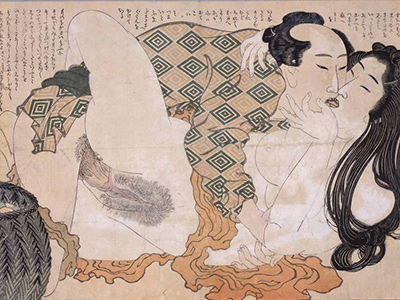Hokusai
Shunga Hokusai

Shunga is a form of Japanese art, more precisely erotic art. The literal translation of the term Shunga is picture of spring. The word spring was often used to refer to sex. A Shunga picture usually takes the form of a woodblock print.
Like most Japanese artists Hokusai produced a number of Shunga albums during his career. Shunga was a kind of art enjoyed by both men and women. It also has a number of superstitions and customs that surrounded it. In 1815 Hokusai produced the Shunga album that is known as ‘The Adonis Plant (Fukujusô)’. Like others, it is a collection of woodblock prints. The print called ‘Two Lovers’ is thought to be the third panel from a series of 12. It is part of a private collection. As well as Japanese text, it shows a fisherman and a woman shell diver. The link with the sea appears in the form of a basket of shells in the bottom left of the print.
Katsushika Hokusai was a Japanese Master artist during the country’s Edo period (1603 – 1868). As an artist, most of his best work took the form of woodblock prints (ukiyo-e). During his long career, he also created works of art known as Shunga. These were also woodblock prints. There is a general acceptance that Hokusai was one of Japan’s best artist in the production of Shunga.
Born in 1760 in Edo (now Tokyo) to an artisan family, Hokusai was an artist best known for Ukiyo-e painting and woodblock printing. During his long career, Hokusai often went by a different name. He is thought to have adopted at least thirty names during his lifetime. The names he took were often the result of the works he created and the style he chose. Because he made frequent changes to his name, it allows for his life to be broken up into periods. Although Hokusai died in Tokyo in 1849, it was not until after his death that his work came to the attention of western artists. Over the years Hokusai’s work has impressed western artists, critics and art lovers alike.